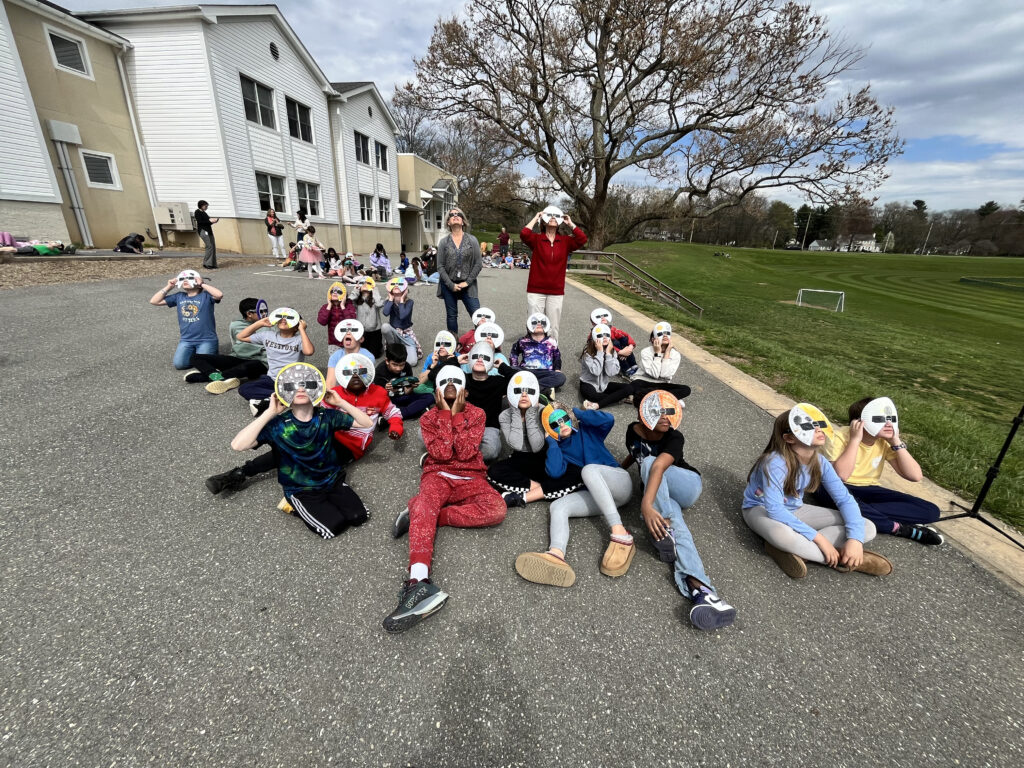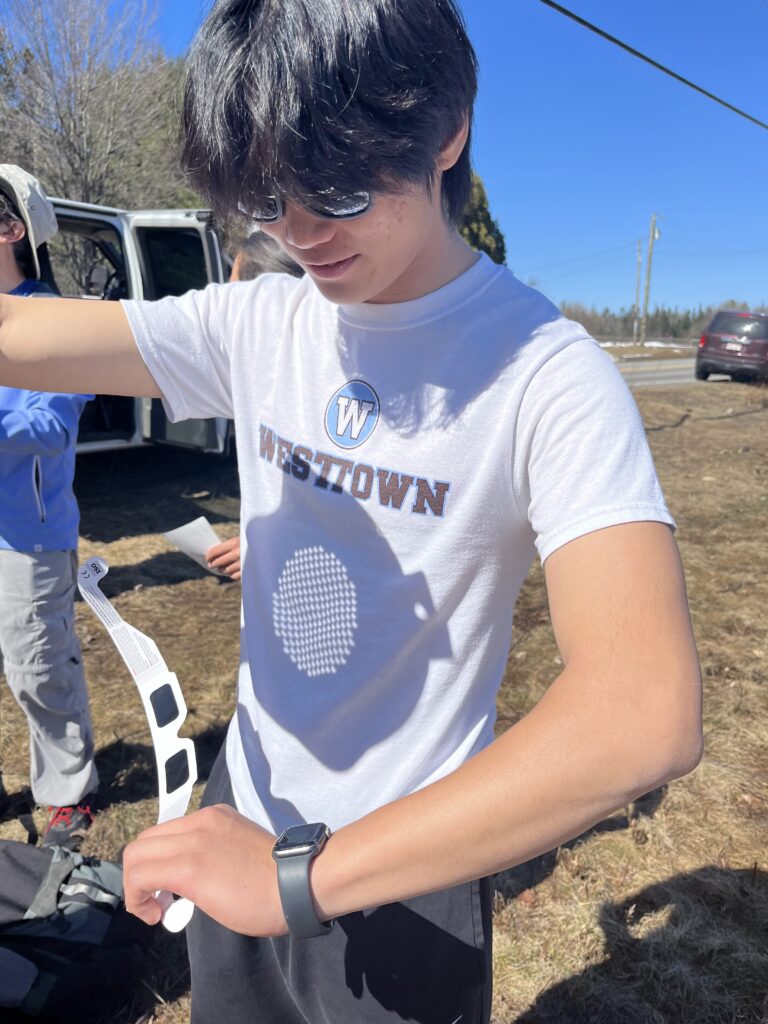- About
- Why ‘Town
- Admission
- Lower School
- Middle School
- Upper School
- Lighting The Way
- Academic Calendar
- Athletics
- Arts
- MyWesttown
- Photos
- Support Westtown
- Alums

Solar Eclipse Viewing Parties Near and Far
As was the case across much of the country, the opportunity to see a total solar eclipse was an event! At Westtown, students attended assemblies to learn about the science of what happens during an eclipse. The school provided Westtown-branded protective eclipse-viewing glasses, and Lower Schoolers made masks to go around them. The kitchen staff even made special eclipse cookies.
At the designated time, students, faculty, and staff spilled out onto campus to witness the spectacle of the eclipse. The lawns were dotted with spectators and a group of students headed for the observatory balcony as well. The sense of joy and community was palpable as everyone marveled at the phenomenon. In our area, the eclipse reached about 89% coverage seen periodically through passing clouds—still an awe-inspiring sight to behold. But far, far away, students in teacher Elson Oshman Blunt’s Astronomy class had a very different experience. He tells the story:
“As soon as I realized my Astronomy class was small enough to fit in a Westtown van, a field trip to the band of totality of the April 8 2024 eclipse felt predestined. But chasing eclipses is not for the faint of heart. Driving for a dozen hours (or two) doesn’t even guarantee that the three-minute experience of totality will succeed. A single errant cloud in just the wrong place at just the wrong moment can scuttle everything. So this was not a mission I could lay at just anyone’s feet. It would have to be the right group of students.
On the first day of the semester, my classroom neighbor and math teacher Jake Norton greeted my students by asking, ‘What class is this? Astronomy, huh? Are you guys gonna go see the eclipse?’ Well, I’d been planning to broach the subject after getting to know my students a little better, but sure, let’s have this conversation now! As it turned out, it didn’t take any convincing. All seven students were all in for the adventure from the get-go.
After some discussion, the school approved the field trip, and a generous parent sponsor offered to cover the costs. Dean of Academics Karen Gallagher even found hotel rooms still available near the iconic Niagara Falls, an absolutely stupendous place to view the eclipse. The trip was on! We were going to see it!
…Or not. Two days out, Niagara’s forecast all but guaranteed complete cloud cover. Following a short-lived period of sad resignation, we turned our attention to the clear skies forecast in New Hampshire and Maine. After all, would you rather drive twelve hours and not see an eclipse, or drive twice as far and actually get to see it? Karen heroically found us new hotel rooms in Portland, Maine, and we were on our way!
Caught up in our eclipse fever, my aforementioned math neighbor and now total hero Jake Norton agreed to help chaperone the trip and share the driving. Ensconced in our valiant Westtown Van #7, the Astronomy students listened to music, chatted, and played trivia games. When we got to our hotel in Portland that night, spirits were high, and despite being pretty tired most of us weren’t ready to go to bed. What started with a little Calculus homework in the lobby turned into card games, interesting conversations, and more class bonding.
The following day, after a few more hours of oddly manageable traffic, we settled into our viewing spot, a random field in the Rangeley Lakes region near the Maine-New Hampshire border. Luckily, we were able to coordinate with friends to meet there, including Dean of Equity, Justice, and Belonging Louisa Egan Brad and her kids. The skies were exceptionally clear and sunny, just as predicted. We were ready! But with an hour to wait, there was plenty of time for more Astronomy learning, and this week’s lesson happened to be measuring and calculating the luminosity of the sun. Perfect! After finishing the lab, the students got our colander and eclipse glasses ready to view the partial eclipse.
The experience of seeing an eclipse is nothing short of wondrous. The special glasses allow less than 0.00032% of the light through, so the Sun looks like a little yellow disk on a completely black background. As the Moon starts to cover the Sun, you see a crescent shape. It looks exactly like the Moon itself, in fact. How ironic that the Sun impersonates the very thing blocking its light! Partial eclipses are weird-looking, but also fun to play with. We projected crescent images of the Sun by letting it shine through tiny holes like a punched piece of paper, fingers arranged in a crosshatch, and the many colander holes.
As totality approached, the light did diminish noticeably, and several of us put on jackets. But even with just a few minutes left for that sliver of Sun and only 5% of its luminosity (I measured!), it was still quite clearly daylight. That all changed dramatically the instant the last ray finally winked out.
In those last few seconds, we saw a faint shimmering, like a strobe light. I’m told these are called ‘shadow bands’ and are caused by atmospheric turbulence. And then, quite suddenly, darkness fell. We could see a faint glow near the southern horizon, presumably the Sun shining outside the band of totality a few miles south of us. It was time to put away our eclipse glasses and gaze upon nature’s most unforgettable sight.
And there it was: a completely round, black disk surrounded by the ghostly solar corona. Normally invisible due to the Sun’s extreme brightness, the corona is the Sun’s outer atmosphere. It’s far hotter than the surface for unknown reasons—in fact, it’s so hot it shines much more brightly to X-ray telescopes than optical ones, but it’s so thin we can’t usually see it. We also saw bright red dots: solar flares peeking out from the edge, a difference from the 2017 eclipse when solar activity was at a minimum. After taking note of all that, there was enough time left for me to settle into a moment of profound spiritual connection with the universe and its grandeur. And then, with a piercing re-emerging ray of light, it was over.
It was time to become road warriors again. And what a drive that turned out to be! During the eight-hour stop-and-go drive to the other end of New Hampshire, we saw one moose, one almost-closed restaurant whose owners thankfully agreed to serve their last three pizzas to one more group of customers, several overrun gas stations which resembled beehives, and thousands of frustrated humans encased in slowly rolling or stopped metal boxes. By the time we arrived at our hotel near Hartford Connecticut, it was 2:00 a.m. and we were exhausted, exhilarated, and still so very excited that we got the chance to see this amazing thing together. By the time we got back to Westtown the following day, we felt very connected as a group and glad for such excellent company to view one of the great wonders of the universe.
While the star of the show was (quite literally) the Sun, and the best supporting actor has to go to the Moon, our trip was an ensemble piece. Thanks to this positive and adventurous crew, our time together was fun and unforgettable not just during those magic two and a half minutes of totality but throughout our entire trip, including the 26 hours we spent in trusty Westtown Van #7. Thanks to every person who helped make this incredible trip a reality.”




